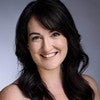Description
Please see attached .pdf chart on the Hamstrings to go along with this lesson.
About This Video
Transcript
Read Full Transcript
Our hamstrings have an origin at our ischial tuberacities, or those little sitting bones that you can feel underneath your pelvis, and they move down and insert on either side of your shin bones. And if you take your hands to the backs of your knees, you can kind of pluck those little feel like banjo strings at the backs of your knees. That's actually the tendons. Muscles will connect to bone via tendons. That's actually the tendons that you're feeling of your three hamstring muscles on each leg.
Now there's so many non-yogis that I meet that say, well I can't do yoga because I have really tight hamstrings. Silly, right? We all come into the room with various range, whether it's from how our bones fit together or just laxity of our muscles. So there's many different ways we can encourage strengthening and space in the hamstring muscles in the backs of our legs. So commonly, what you might see in a seated forward bend like Paschimottanasana, or really any of your forward bends in your practice, is that when people come to sit upright on their bowl of their pelvis, they're dragging a little bit back because of this tightness.
One thing of course that we can do to adapt the pose is bending the knees, and so you're sitting a little bit taller on the feet of the pelvis, on the ischial tuberosities, and then taking your forward bend from there so you're just creasing at your hips rather than bending from your back, which is kind of death and destruction to your lower back space. Now once you get a little bit more mobile, what's considered a healthy amount of flexibility in the back compartment, in the hamstrings, lower back and lower legs, is about here. Sitting up in a tall spine, kind of looking like a 90 degree angle, just about here, and then maybe, who knows, about here. Now if you've been in a yoga asana group class lately, what you see is a lot of variation and a lot of really wild ask of our hamstrings. So let's look at how to do that in a more balanced way.
One verbal cue that I hear a lot is take your hands to the flesh of the tush and move it back, or move it out. Teachers are real fond of moving this butt flesh out of the way. I'm going to say to you, save your butt flesh, gather it up, even tuck it a little bit underneath you. You got it? Use it, right?
Because that kind of flailing out of your butt flesh and your exposing of the sitting bones on the floor can irritate the bursa, and bursa's a little fluid filled sack that rests between the hamstring attachment and the bony sitting bone. Tendons and these bursas are not wimpy critters. They're tough, almost like a rock climbing rope, real tough and pretty hardy. But if you imagine rubbing a rock climbing rope on a boulder repeatedly, what's going to happen? It's going to fray, it's going to weaken, worst case scenario, snaps, right?
This is really kind of like our hamstrings. We don't want to irritate them by kind of removing and flailing out the flesh. We want to keep some of that, keep some of what your mama gave you underneath, right? If you'd like to go a little bit deeper, often when we get really mobile, and I'm talking to a lot of the yoga teachers out there and advanced yogis, when we get really mobile, we tend to right of the pelvis, ward, reaching the sitting bones back behind. We even do that little dance of pulling the flesh out from underneath us, again, that can rub and irritate, inflaming that bursa, inflaming that tendon.
And it's such a common injury in yoga classes, yoga populations now, that physical therapists have termed it yoga butt. And the proper term is ischial gluteal bursitis, but what people are terming it as yoga butt, I often call it teacher training butt, because a lot of teacher trainers are taking many more classes, they're being asked to sit for long periods of time and then jump into a posture and exaggerate it. So this is something that can develop. You might notice, not that we're going to diagnose it ourselves, but we might notice this dull ache in the sitting, but you kind of point to it, it gets worse with movement. This is something that a lot of us will enter into, unfortunately, in these practices.
So if you have enough mobility that you can sit upright and maybe even touch your toes, what you want to add to your practice, if you choose to go a little bit deeper into your postures, is actually drawing your sitting bones energetically down towards the heels. This is active heel and sitting bone towards one another instead of away from one another. You could also think of it as hugging the sitting bones together. You can think of it, you may not feel comfortable saying this to a class, but you can think of it as hugging the anal sphincter or ashwini mudja in or like the tail is hugging in towards your anal sphincter. This is always of muscular engaging, so as we're asking for a stretch, the stretch will be translated more into the meaty belly of the muscle rather than the more kind of puny delicate attachments of the muscle.
So save your tush the drama, keep the flesh underneath you, and have happy hamstrings in your practice.
Your Body on Yoga: Lower Appendage
Comments
You need to be a subscriber to post a comment.
Please Log In or Create an Account to start your free trial.














